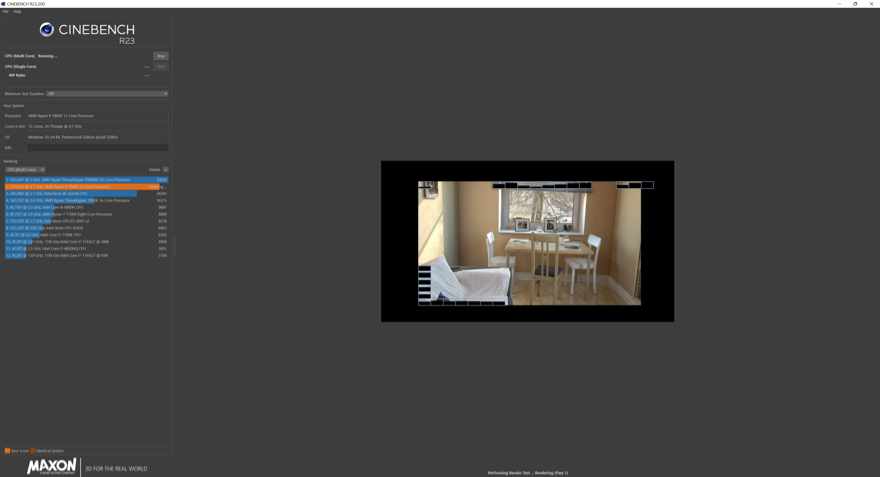Intel 14th Generation CPU Review Feat i5 14600K, i7 14700K & i9 14900K
Andy Ruffell / 1 year ago

Blender 3.3.0
Blender Open Data is a platform to collect, display and query the results of hardware and software performance tests – provided by the Blender community.
Available now on Blender.

In our first rendering benchmark, the i5 14600k comes in 15% faster than its predecessor, while the 14700K commands a still somewhat impressive 12% lead over the 13700K and again leapfrogs AMD’s 7900X. Sadly, the flagship i9 doesn’t see as much of a performance increase at just 4% and still gets beaten by both the Ryzen 9 7950X and 7950X3D by over 9%.
Cinebench R23
Cinebench is a real-world cross-platform test suite that evaluates your computer’s hardware capabilities. Improvements to Cinebench Release 23 reflect the overall advancements to CPU and rendering technology in recent years, providing a more accurate measurement of Cinema 4D’s ability to take advantage of multiple CPU cores and modern processor features available to the average user. Best of all: It’s free.
Available now on Maxon.

In Cinebench R23, the improvements really show in the multi-core score with a gen to gen increase of 8% on the i5, while single core comes in a slightly less 4%, though does push the i5 up the stack slightly, now performing better than the i7 12700K. Speaking of i7’s, the 14700K comes in a much healthier 17% faster than the 13700K, which while it doesn’t do much in terms of the order of our chart, it’s still a nice increase to see, though the same can’t be said for the single core test, which only sees a less than 2% uplift gen to gen. Lastly, the i9 which was already leading our charts by less than 1% over the Ryzen 9 7950X has now seen a 3% increase, which now pushes that gap over AMD to a little over 4%.
Corona 1.3
Test and compare the performance of your CPU using this free benchmark application, which is built upon Corona Renderer 1.3.
Available now on Corona

Corona sees some strong reductions in render time, with the i5 shaving off 9% of its render time gen to gen, the i7 seeing a much healthier 14% decrease, and the i9 coming in 5% faster, which now matches the performance of the 7950X at just 36 seconds.
Keyshot Viewer 11.2.1
KeyShot Viewer is a free, stand-alone desktop application that enables secure sharing of KeyShot scenes for interactive, photo-realistic 3D model viewing, presentation and configuration, using the same real-time ray tracing render engine as KeyShot to produce amazing visuals with speed and quality.
Available now on KeyShot.

In Keyshot viewer the gains are even more impressive with the i5 and i7 now coming in 18% faster, which puts the i5 ahead of the Ryzen 5000 series, while the i7 again pushes ahead of the Ryzen 9 7900X which is pretty impressive to see, though the i9 somewhat falls flat on its face, with less than a 1% gain in performance, which still sees Intel sitting 2% lower than AMD’s 7950X.
V-Ray 5.00.20
V-Ray® Benchmark is a free standalone application to test how fast your system renders. It’s simple, fast and includes three render engine test.
Available now on Chaos.

In V-Ray there are strong performance increases again of 7% on the i5, and 16% on the i7, though again, the i9 is the odd one out, with just a 3% performance uplift compared to its predecessor which still isn’t enough to reach the performance levels of the Ryzen 9 7950 and 7950X3D.
PugetBench For Davinci Resolve
PugetBench For Davinci Resolve is a benchmark tool developed by Puget Systems to allow you to compare hardware that is utilised by Davinci Resolve. A piece of software that we at eTeknix use on a daily basis to edit, grade and render our YouTube videos.
Available now on Puget Systems.

Pugetbench was a bit of an odd one, as all three CPUs saw performance drops in the extended test, which could be down to a variety of factors including thermals, silicon lottery or PugetBench along with Davinci just not geared for these new processors fully. Either way, for those who use their systems for video rendering, it’s not looking great.



















